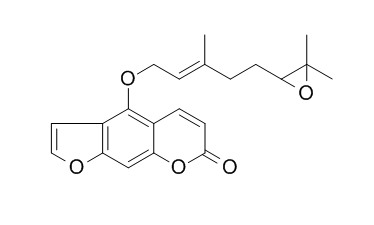Epoxybergamottin
Epoxybergamottin is an inhibitor of CYP3A4, it also displays significant inhibition of superoxide anion generation and elastase release.
Inquire / Order:
manager@chemfaces.com
Technical Inquiries:
service@chemfaces.com
Tel:
+86-27-84237783
Fax:
+86-27-84254680
Address:
1 Building, No. 83, CheCheng Rd., Wuhan Economic and Technological Development Zone, Wuhan, Hubei 430056, PRC
Providing storage is as stated on the product vial and the vial is kept tightly sealed, the product can be stored for up to
24 months(2-8C).
Wherever possible, you should prepare and use solutions on the same day. However, if you need to make up stock solutions in advance, we recommend that you store the solution as aliquots in tightly sealed vials at -20C. Generally, these will be useable for up to two weeks. Before use, and prior to opening the vial we recommend that you allow your product to equilibrate to room temperature for at least 1 hour.
Need more advice on solubility, usage and handling? Please email to: service@chemfaces.com
The packaging of the product may have turned upside down during transportation, resulting in the natural compounds adhering to the neck or cap of the vial. take the vial out of its packaging and gently shake to let the compounds fall to the bottom of the vial. for liquid products, centrifuge at 200-500 RPM to gather the liquid at the bottom of the vial. try to avoid loss or contamination during handling.
J Pharmacol Sci.2021, 147(2):184-191.
Int J Mol Sci.2023, 24(8):7442.
Eur J Pharmacol.2021, 906:174220.
Toxicol Appl Pharmacol.2021, 427:115668.
Toxicol Rep.2021, 8:1131-1142.
Anal Bioanal Chem. 2016, 408(15)
Adaptive Medicine 2020, 12(1): 4-10
Fitoterapia.2024, 106006.
J Ethnopharmacol.2020, 260:112988.
bioRxiv-Pharm.&Toxi.2022, 2022.481203.
Related and Featured Products
European journal of clinical pharmacology, 2003, 58(10):663-668.
Identification of epoxybergamottin as a CYP3A4 inhibitor in grapefruit peel.[Reference:
WebLink]
The oral availability of many drugs metabolised by the enzyme cytochrome P 450 3A4 (CYP3A4) is increased if co-administered with grapefruit juice. Extracts from grapefruit peel have also demonstrated inhibitory activity and, during commercial manufacturing of grapefruit juice, inhibitory components might be squeezed into the juice from the peel. Thus, the aim of this in vitro study was to identify CYP3A4 inhibitors in grapefruit peel.
METHODS AND RESULTS:
Grapefruit peel was extracted with diethyl ether, and the extract was further fractionated by normal-phase chromatography. Fractions demonstrating significant CYP3A4 inhibitory activity, as measured by the relative reduction in N-demethylation of diltiazem in transfected human liver epithelial cells, were subsequently separated by preparative thin-layer chromatography. Constituents of the fractions and isolated compounds were identified by nuclear magnetic resonance spectroscopy. Analysis of diltiazem and N-demethyl-diltiazem was performed using high-performance liquid chromatography.
Of the identified components in grapefruit peel, only Epoxybergamottin demonstrated a concentration-dependent inhibition of the CYP3A4-mediated N-demethylation of diltiazem. The IC50 value was calculated to be 4.2±1.1 µM. Coumarins without the furan ring and flavonoids isolated from grapefruit peel did not interfere with the metabolism of diltiazem. The results indicated the presence of other CYP3A4 inhibitors in grapefruit peel, but these agents were lost during the purification process excluding their identification.
CONCLUSIONS:
The furanocoumarin Epoxybergamottin, present in grapefruit peel, is an inhibitor of CYP3A4. In commercial manufacturing of grapefruit juice, Epoxybergamottin is possibly distributed into the juice. During manufacturing, however, Epoxybergamottin may be hydrolysed to 6´,7´-dihydroxybergamottin, which has been suggested as an important CYP3A4 inhibitor in grapefruit juice.
Molecules, 2017, 22(6):967.
Anti-Inflammatory and Neuroprotective Constituents from the Peels of Citrus grandis.[Reference:
WebLink]
METHODS AND RESULTS:
A series of chromatographic separations performed on the ethanol extracts of the peels of Citrus grandis has led to the characterization of forty compounds, including seventeen coumarins, eight flavonoids, two triterpenoids, four benzenoids, two steroids, one lignan, one amide, and five other compounds, respectively. The chemical structures of the purified constituents were identified on the basis of spectroscopic elucidation, including 1D- and 2D-NMR, UV, IR, and mass spectrometric analysis. Most of the isolated compounds were examined for their inhibition of superoxide anion generation and elastase release by human neutrophils.
CONCLUSIONS:
Among the isolates, isomeranzin (3), 17,18-dihydroxybergamottin (12), Epoxybergamottin (13), rhoifolin (19), vitexicarpin (22) and 4-hydroxybenzaldehyde (29) displayed the most significant inhibition of superoxide anion generation and elastase release with IC50 values ranged from 0.54 to 7.57 μM, and 0.43 to 4.33 μM, respectively. In addition, 7-hydroxy-8-(2'-hydroxy-3'-methylbut-3'-enyl)coumarin (8) and 17,18-dihydroxybergamottin (12) also exhibited the protection of neurons against A-mediated neurotoxicity at 50 μM.



